KYIV:One month of the war, still defiant. With its government still standing and its outnumbered troops battling Russian forces to bloody stalemates on multiple fronts, Ukraine is scarred, wounded and mourning its dead but far from beaten.
When Russia unleashed its invasion Feb. 24 in Europe's biggest offensive since World War II and brandished the prospect of nuclear escalation if the West intervened, a lightning-swift toppling of Ukraine's democratically elected government seemed likely. But with Wednesday marking four full weeks of fighting, Russia is bogged down in a grinding military campaign, with untold numbers of dead, no immediate end in sight, and its economy crippled by Western sanctions. U.S. President Joe Biden and key allies are meeting in Brussels and Warsaw this week to discuss possible new punitive measures and more military aid to Ukraine.
As Biden left the White House on Wednesday for the flight to Europe, he warned there is a "real threat" Russia could use chemical weapons and said he will discuss that danger with the other leaders. The war's economic and geopolitical shockwaves — with soaring energy prices, fears for global food supplies, and Russia and China aligning in a new world order with echoes of the Cold War — have reverberated across a planet yet to emerge from the COVID-19 crisis.
With his olive-drab T-shirts, unshaven face and impassioned appeals to governments around the world for help, Ukrainian President Volodymyr Zelenskyy has been transformed into a wartime leader and Russian President Vladimir Putin's No. 1 antagonist. Addressing Japan's parliament on Wednesday, Zelenskyy said four weeks of war have killed thousands, including at least 121 of Ukraine's children.
"Our people cannot even adequately bury their murdered relatives, friends and neighbors. They have to be buried right in the yards of destroyed buildings, next to the roads," he said. Repeatedly pushed back by hit-and-run Ukrainian units armed with Western-supplied weapons, Russian troops are shelling targets from afar, falling back on tactics they used in reducing cities to ruins in Syria and Chechnya.
Major Russian objectives remain unfulfilled. The capital, Kyiv, has been repeatedly hit but not taken or even encircled. More shelling and gunfire shook the city Wednesday, with plumes of black smoke rising from the western outskirts, where the two sides battled for control of multiple suburbs. A shopping mall and other buildings were hit, injuring four people, city officials said. Mayor Vitali Klitschko, said at least 264 civilians have been killed in the capital since war broke out.
In the south, the port city of Mariupol has seen the worst devastation of the war, under weeks of siege and bombardment. But Ukrainian forces have prevented its fall, thwarting an apparent bid by Moscow to secure a land bridge from Russia to Crimea, seized from Ukraine in 2014. Zelenskyy said 100,000 civilians remain in the city, which had a pre-war population of 430,000. It has been shattered by strikes from air, land and sea, and repeated efforts to get desperately needed food and other supplies to those trapped have often failed.
"They bombed us for the past 20 days," said 39-year-old Viktoria Totsen, who fled from Mariupol into Poland. "During the last five days, the planes were flying over us every five seconds and dropped bombs everywhere — on residential buildings, kindergartens, art schools, everywhere." Zelenskyy, speaking Tuesday in his nightly video address to his nation, said efforts to establish humanitarian corridors for Mariupol residents are almost all being "foiled by the Russian occupiers, by shelling or deliberate terror."
